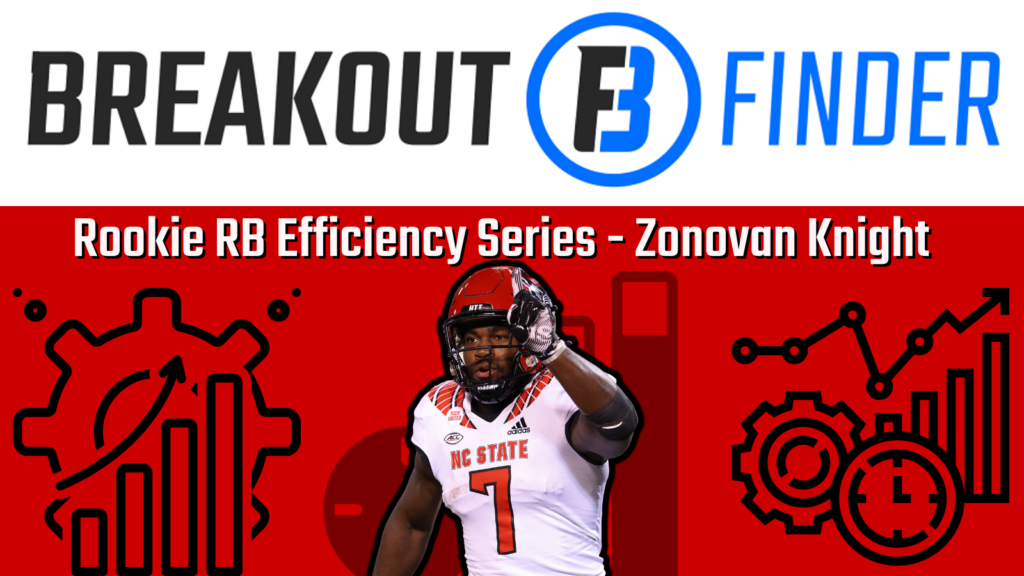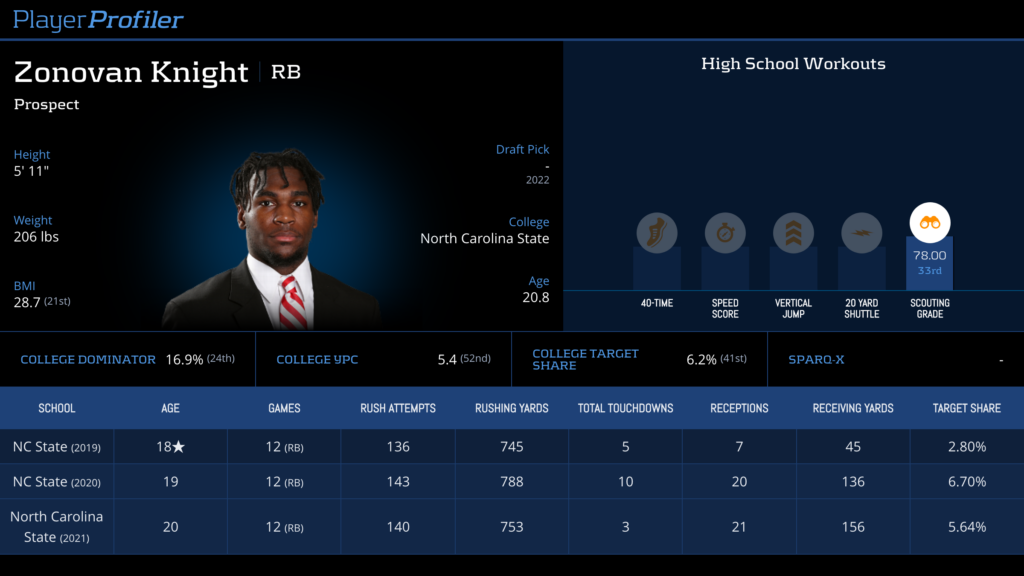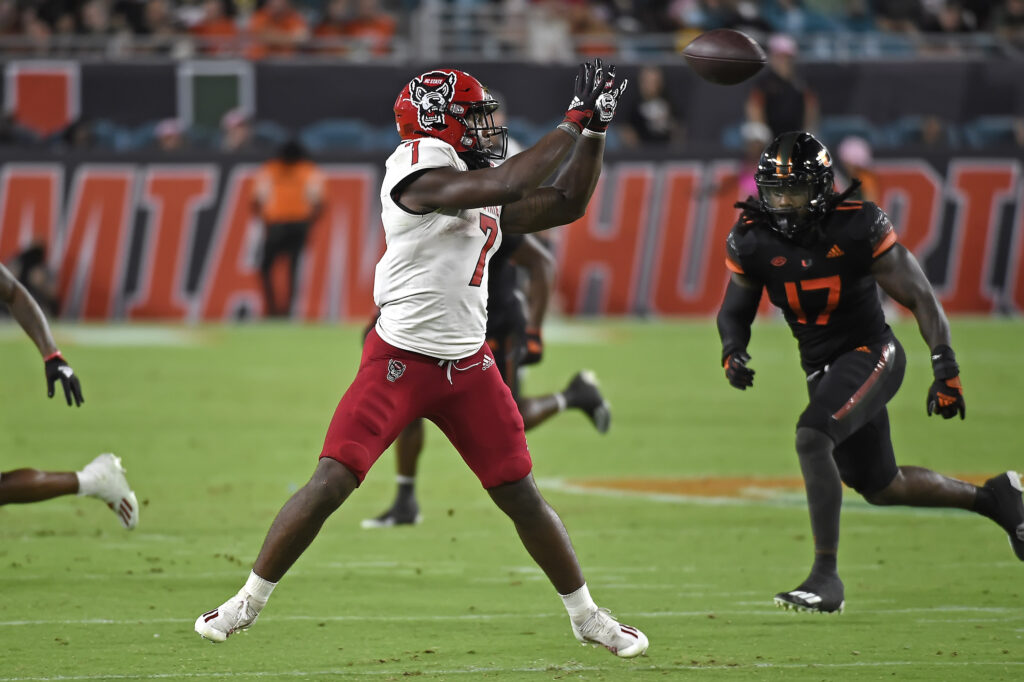North Carolina State’s Zonovan Knight is the next subject in a series in which I evaluate 2022 rookie running backs solely on their ability to run the ball. The first installments can be found here. If you happened to already catch those and don’t need a refresher on my methodology, feel free to skip to the player-focused analysis.

Zonovan Knight spent three seasons at North Carolina State and never was the clear lead back, as he shared time with dudes in Jordan Houston and Ricky Person that have names that sound like randomly generated CPU players on NFL Street 2. However, during his time as a member of the Wolfpack, Knight xzibited (eh? good one right?) both quality receiving skills and slickness as a ballcarrier.
The Metrics
On a relatively modest 419 career carries, the man they call “Bam” Knight outperformed a 62nd-percentile group of backfield teammates (based on their collective 3.56-star average rating as high school recruits) by 0.90 yards per carry. This is a 65th-percentile number among running backs drafted since 2007. He was great at navigating the line of scrimmage and slaloming through the first levels of the defense. His career Chunk Rate+ is a 4.35-percent mark, landing in the 80th-percentile. There was not a single season in which Knight was outperformed by his teammates in YPC or Chunk Rate.

In the open field, Knight was fairly mediocre. Though his career-best 40-percent Breakaway Conversion Rate on 140 carries in 2021 would be an 88th-percentile figure. On the aggregate, he converted just 24.9-percent of his chunk gains into longer breakaways. Coincidentally, a display of open-field running in the 24th-percentile.
If we account for Knight’s team-relative efficiency against various box counts, we find that his average carry was worth 127.9-percent the output of carries from other Wolfpack runners, a BAE Rating in the 84th-percentile. He did see lighter average box counts than his backfield mates. But the only individual box counts that he failed to outperform them against were four and five-man boxes, where his 38 combined carries accounted for just nine-percent of his total rushing attempts.
Rushing Efficiency Score and Comps
According to my running back model’s Rushing Efficiency Score (which accounts for all the non-BAE metrics touched on in this article, in addition to rushing volume, overall team quality, strength of opponent, and offensive line play), Knight earns a 60.7 out of 100. His score in a prototype BAE-centric composite that I’m using is a 63.4. So I’m fairly confident in Knight’s being a quality runner of the football.
My model also generates comps. Using the same inputs as the Rushing Efficiency Score in addition to physical measurables, it finds similarity scores between current and past prospects in the “pure runner” category. If Bam is 5-11, 210-pounds, and runs a 4.50 40-yard dash, the following players are his 10 most similar from that perspective:

If he is 210-pounds at 5-11, Knight will be a relatively slim running back. At that point, his ability as a pass-catcher will be an important determinant in his potential to receive opportunity in the NFL. As a runner though, he looks pretty nice. The “high Chunk Rate+, low Breakaway Conversion Rate” avenue to a positive YPC+ number is one that is fairly immune to being secretly bad or fool’s gold in some way.
The Chris Carson Corrollary
I’ve touched on the Jeremy McNichols Corollary (the idea that high team-relative efficiency that is largely fueled by long runs can indicate a raw skillset that is unlikely to translate to the next level) in a few of these rushing efficiency articles, and Zonovan Knight‘s profile is to the complete opposite effect. If you’re outdoing the efficiency of your teammates in spite of a lack of big plays, you’re probably accomplishing that feat because you’re a better player with a more refined skillset. Obviously you’d rather your running back prospects have it all. But if choosing between a positive YPC+ mark accompanied by either a high Chunk Rate+ or a high Breakaway Conversion Rate, give me the high Chunk Rate+.
I’m calling this one The Chris Carson Corollary; his 13.87-percent, 99th-percentile Chunk Rate+ propelled him to a 1.62 (88th-percentile) YPC+ in spite of a 15.5-percent, 4th-percentile BCR.
Last Word
Naturally, falling in line with the Chris Carson Corollary is not a skeleton key to NFL success. #RBsDontMatter means that you need to be an especially good or especially bad runner to make much of a difference in the league. Zonovan Knight is simply fine. An occupant of the fat part of the pure running ability bell curve, he needs something else to differentiate him. Generally, that differentiator results in draft capital and comes in the form of college production, top-end receiving ability, or sexy athleticism. I can’t speak to Knight’s athletic profile until he tests at the Combine. But his production profile and receiving skillset, while not bad, are fairly underwhelming. Because of that, I don’t anticipate him being a guy that the NFL cares too much about.

The fate for a player like this is highly dependent on situational factors that are nearly impossible to predict. But that’s really just another way of calling a dude a JAG. Throw Knight on your taxi squad. Maybe he makes a nice tackle on special teams in the preseason and gets a shot to carry the ball when a starter goes down. But I’m not hoping for much more. While a quality JAG, he’s a JAG nonetheless. And you’d do well to not fall in love with random JAGs in your rookie drafts.


